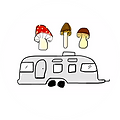What Makes a Mushroom, a 'Bolete' Mushroom?
- Kara Thornton
- Jun 27, 2022
- 2 min read
Updated: May 23, 2023
'Bolete' - Maybe you've heard the term, maybe you haven't... Either way, after learning this word, identifying mushrooms should seem a little less daunting!

Cluster of Tylopilus plumbeoviolaceus "Violet-Gray Bolete" Wilkesboro, NC Aug. 2021

Recently we've taken a look at other fungi categories like chanterelles and amanitas... Now as we officially enter the summer season, boletes will emerge!
Generally these mushrooms considered Boletes feature a plump body with a spongey pore surface made up of tiny tubes that extend down from the cap.
Of course, in typical mushroom fashion there is a handful of "Gilled Boletes" so don't get too comfortable...
But bear with us! Bolete mushrooms can display some of the most beautiful colors in the mushroom world. Many Boletes are already colorful, and then stain different colors, creating an almost tie-dye look as they bruise.
See gallery below:
The term 'bolete' can refer to any species in the Boletaceae family, or sometimes more specifically, the Boletus genus. But, not all mushrooms that fall under this umbrella term 'bolete' belong to this genus.
For example, these mushrooms, commonly known as 'Old Man of the Woods,' belong to the Strobilomyces genus, but are considered boletes due to their spongey pore surface.
Strobilomyces strobilaceus
Basic Terms Used in Bolete Mushroom Identification

Scabers: an organic speckled pattern made of small, stiff granular projections

Reticulation: a netting pattern, either faint and flush or robust and textured

Staining: when the flesh of a mushroom bruises a different color
Basic Tips for Identifying Bolete Mushrooms
Observe the cap: texture, colors, and shape.
Gently pull the mushroom up from the base, trying your best to keep the mycelium in tact as you pull it up from the ground. Mycelium color is a big help in properly identifying bolete mushrooms.
Once you've got a visual of the entirety of the mushroom, study the shape of the stipe, look for any reticulation, scabers, or smooth textures.
Observe the underside of the cap, the color, the size of the pores, and mark it a couple times to see if the pore surface stains any color.
Next use your knife to slice a cross-section of the mushroom. Here you can study the staining of the body of the mushroom and the pore tubes to see whether they're deep or shallow compared to the cap flesh.
Last week we encountered a new bolete and took note of its characteristics:
As a general rule of thumb: if you can help it, don't always pluck mushrooms from their substrate. BUT - for identification purposes, it does help to be able to study the entirety of the mushroom; therefore, if you're making an intentional decision to properly ID a new mushroom, definitely pluck it from the ground in order to analyze all parts of the mushroom.
.png)






















The Sage Law Group handled my family legal matter with professionalism and empathy. Their knowledgeable team explained Family Court processes and guided me carefully through every step. https://thesagelawgroup.ca/ dedication to client care is outstanding. I highly recommend them.